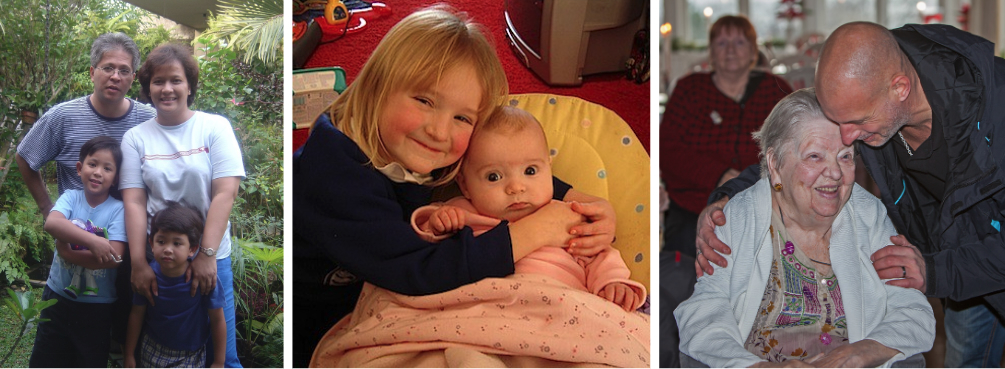4.2 Nurturance: Caring for Others
Wesley Sharp and Elizabeth B. Pearce
Caregiving and being cared for is one of the critical aspects of kinship and family life. All of us have been parented in one form or another. In addition, many provide caregiving and nurturance to children, younger adults, and other adults who need or desire assistance (figure 4.1).
Perhaps the most emphasized caregiving role in the United States is that of “parent,” but it is important to realize that this too is a social construction. Some are parents via biological creation, but others become parents via other familial relationships such as grandparenting. There are legally assigned adoptive and foster parents. And there are those who fully meet the caregiver and provider definition of parent but have neither legal nor biological ties to those in their charge.
In this section we will discuss parenting, grandparenting, and other nurturing relationships. We will also examine the horizontal and vertical relationships related to kinship and caregiving.

A caregiver provides nurturance or support to another person in some way, shape, or form. Other than parenting, caregiving also covers areas regarding the care of adults, elders, individuals who are disabled or ill, and people who fall anywhere in the spectrum of not being able to have their full needs met without the assistance of others.
Now that the baseline meaning of a caregiver is defined, let’s explore the different, deeper aspects of nurturance and how people may or may not get the proper care that they need. We will examine the ways in which institutional power, influence, and discrimination impact these critical relationships. We will discuss theories related to parenting and other nurturing relationships. And we will continue to note the ways that societal perceptions impact families—the ways that some kinship groups are harmed or limited and others are privileged—in their experience with nurturance, caregiving, and receiving care.
As introduced in Chapter 1, one way to view families is through their private and public functions. In this chapter, the focus is on the public function of families: the caregiving and nurturing of family members, with a focus on children. Other public functions include caring for disabled adults and older family members (Cherlin, 2017).
Another example of this function is older family members caring for grandchildren or helping run households for and with their adult children. The relationships can also be bidirectional when multigenerational households share caregiving, financial, and household responsibilities, as pictured in figure 4.2. These kinds of households have consistently been more common in other countries and within some cultures in the United States, such as in Latine communities. They are now becoming more common among the White middle-class demographic that previously embraced the nuclear family. Demographic and societal forces have contributed to these changes.

Comprehension Self Check
Licenses and Attributions for Nurturance: Caring for Others
Open Content, Original
“Nurturance: Caring for Others” by Elizabeth B. Pearce and Wesley Sharp. License: CC BY 4.0.
Open Content, Shared Previously
Figure 4.1 “Family (3).jpg” by Freelancecynic is licensed under CC BY-NC-SA 2.0., “The family” by TukangRoti is licensed under CC BY-NC-ND 2.0. And “IMG_7704” by Bengt Nyman is licensed under CC BY 2.0.
Figure 4.2. “Dah-party 03” by Chona Kasinger and Disabled and Here. License: CC BY 4.0.
References
Cherlin, Andrew. Public and Private Families: An Introduction. McGraw Hill. 2017. https://www.mheducation.com/highered/product/public-private-families-introduction-cherlin/M9781260813272.html
the act of providing support or watching over a person.
the social structure that ties people together (whether by blood, marriage, legal processes, or other agreements) and includes family relationships.
meaning assigned to an object or event by mutual agreement (explicit or implicit) of the members of a society; can change over time and/or location.
can include the emotional significance of an action or way of being; the intention or reason for doing something; something that we create and feel; closely linked to motivation.
the unequal treatment of an individual or group on the basis of their statuses (e.g., age, beliefs, ethnicity, sex).
focuses on contributions to society such as the production of children or caring for others.
a family group that consists of two parents and their children living together in one household.

